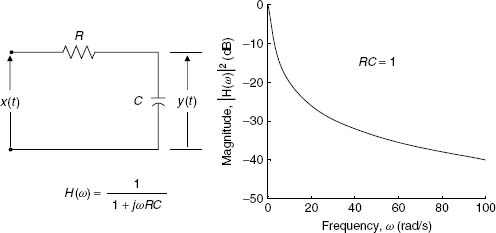2.3 REVIEW OF CONVOLUTION AND FILTERING
A linear time-invariant (LTI) system configuration is shown in Figure 2.5. A linear filter satisfies the property of generalized superposition and hence its output, y(t), is the convolution of the input, x(t), with the filter impulse response, h(t). Mathematically, convolution is represented by the integral in Eq. (2.4):
![]()

Figure 2.5. A linear time-invariant (LTI) system and convolution operation.

Figure 2.6. A simple RC low-pass filter.
The symbol * between the impulse response, h(t), and the input, x(t), is often used to denote the convolution operation.
The CFT of the impulse response, h(t), is the frequency response of the filter, i.e.,
![]()
As an example for reviewing these fundamental concepts in linear systems, we present in Figure 2.6 a simple first-order RC circuit that corresponds to a low-pass filter. The impulse response for this RC filter is a decaying exponential, and its frequency response is given by a simple first-order rational function, H(ω). This function is complex-valued and its magnitude represents the gain of the filter with ...
Get Audio Signal Processing and Coding now with the O’Reilly learning platform.
O’Reilly members experience books, live events, courses curated by job role, and more from O’Reilly and nearly 200 top publishers.

